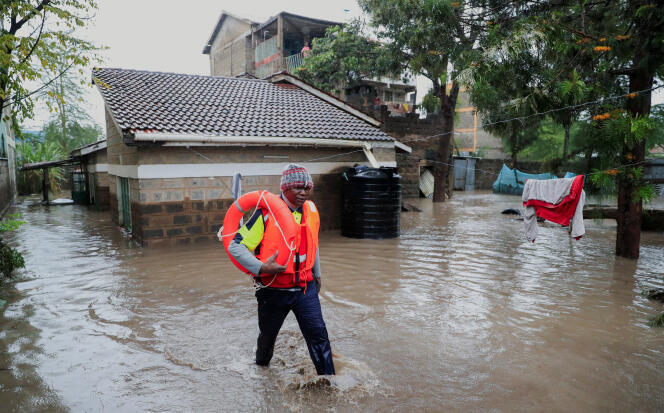On the scene of a search and rescue operation after flash floods destroyed several houses, in the village of Kamuchiri, Kenya, on April 30, 2024. MONICAH MWANGI / REUTERS
Searches are conducted by scent, or by following the eyes of scavengers flying over the mounds of trees and mud. In Kenya, around 100 people are still missing in the vicinity of Mai Mahiu, a locality in the Rift Valley some 50 kilometers from Nairobi, where a landslide caused by torrential rains claimed the lives of at least 50 people on Monday, April 29. Lost in thought, Edward Kinenji was searching the banks of the ochre-colored river. Stick in hand, he scanned the thick mud where uprooted acacias, monkey corpses, and car wrecks lay jumbled together. Upstream, a reservoir that had built up over the months around a disused railway tunnel gave way under the pressure of heavy rains. The torrent swept away a section of mountain on Monday night, then hundreds of homes downstream.
“The water caught us at 3 am. I was able to rescue my wife and children, but I lost everything else: my 100 head of cattle and my house,” confided Kinenji from the flooded banks, where the army had been deployed to recover the bodies of the missing. A flood of this magnitude is unprecedented in the region, assured Kinenji, who has been herding goats here for 15 years and had never experienced anything like it. Makarios Kamariu, a neighbor, was unable to warn his family in time as the waters tumbled down the slope. “The outbuilding where my two teenagers lived was swept away before my very eyes, and the next morning I found their bodies 300 meters below,” said the father.
One of Kenya’s worst-ever disasters
The heavy rains that have been battering East Africa for the past month and a half are, in some regions, three times the normal seasonal levels. While the Mai Mahiu landslide is one of Kenya’s worst disasters, flooding has claimed at least 188 lives and displaced 200,000 people since the start of the rainy season in March.
After the first violent episode in November 2023, when the rains had already caused the death of 250 people and displaced a million in East Africa, Kenya once again finds itself powerless in the face of these floods. The heavy rains are the consequence of two parallel phenomena: the El Niño weather event and the Indian Ocean Dipole, another climatic anomaly – when the water surface temperature of the Indian Ocean is above normal to the west of it and below normal to the east.
 A member of the Kenyan Red Cross after a seasonal river burst its banks, Kitengela, Kenya, May 1ᵉʳ, 2024. THOMAS MUKOYA / REUTERS
A member of the Kenyan Red Cross after a seasonal river burst its banks, Kitengela, Kenya, May 1ᵉʳ, 2024. THOMAS MUKOYA / REUTERS
“This is one of the most violent El Niño episodes since 1950,” said Reena Ghelani, UN Under-Secretary-General for El Niño Response. “Between 40 and 50 million people are affected in 16 countries.” The last major crisis, in 1997, caused the death of over 6,000 people in East Africa.
You have 61.36% of this article left to read. The rest is for subscribers only.
Source link : https://www.lemonde.fr/en/le-monde-africa/article/2024/05/03/kenya-hit-by-one-of-the-most-violent-el-nino-episodes-since-1950_6670291_124.html
Author :
Publish date : 2024-05-03 07:00:00
Copyright for syndicated content belongs to the linked Source.





